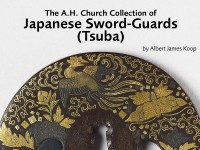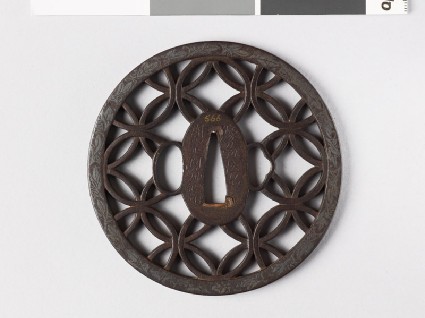The A. H. Church Collection of Japanese Sword-Guards (Tsuba)
An unpublished catalogue of the A. H. Church collection of Japanese sword-guards (tsuba) by Albert James Koop.

Publications online: 1264 objects
Round tsuba with interlacing rings and leaves
-
Literature notes
Symmetrically pierced, with slight modelling, as a large pattern of slender interlacing rings within the stout border; the latter covered on each face with leaves and tendrils in silver nunome.
Signed: Yoshū Matsuyama ("of M. in Iyo province") Moriyama [Japanese text] Shōami Kanemichi [Japanese text], and, on the back, Morikuni [Japanese text] kore wo saku, with date Kiōhō XII (1727), 6th month.
Apparently Moriyama is a surname of Kanemichi, one of the artists responsible for the guard, the other being Morikuni. Shōami is, after all, an art-name (of Buddhistic flavor) first, and a surname afterwards.
Wada (p.69) quotes various dated guards by Morikuni, of Yenki III (1746), Kiōhō XI (1726), etc. Kanemichi, however, he does not mention. -
Details
- Associated place
- Date
- 1727
- Artist/maker
-
Shōami Morikuni (active first half of the 18th century) (armourer)Shōami School (active 1601 - 1909) (armourer)Iyo-Shōami (possibly active 1601 - 1909) (armourer)
- Material and technique
- iron, with cut and filed openwork decoration, and silver nunome-zōgan decoration; tang-hole plugged with soft metal, probably copper
- Dimensions
- 9.6 x 9.6 cm (height x width)
- Material index
-
processed material › metal › iron,
- Technique index
-
cut,
- Object type index
-
arms/armour › koshirae › kodogu › tsuba
- No. of items
- 1
- Credit line
- Bequeathed by Sir Arthur H. Church, 1915.
- Accession no.
- EAX.10249
-
Further reading
Koop, Albert James, The A. H. Church Collection of Japanese Sword-Guards (Tsuba), 3 vols (Oxford, Ashmolean Museum, 1929), no. 249
Glossary (2)
nunome-zōgan, tsuba
-
nunome-zōgan
Decorative application of metal sheeting (generally of gold or silver) where the iron ground is first cross-hatched and the metal burnished on.
-
tsuba
Japanese sword guard.
Location
-
- currently in research collection
Objects are sometimes moved to a different location. Our object location data is usually updated on a monthly basis. Contact the Jameel Study Centre if you are planning to visit the museum to see a particular object on display, or would like to arrange an appointment to see an object in our reserve collections.
Publications online
-

The A. H. Church Collection of Japanese Sword-Guards (Tsuba)
Symmetrically pierced, with slight modelling, as a large pattern of slender interlacing rings within the stout border; the latter covered on each face with leaves and tendrils in silver nunome.
Signed: Yoshū Matsuyama ("of M. in Iyo province") Moriyama [Japanese text] Shōami Kanemichi [Japanese text], and, on the back, Morikuni [Japanese text] kore wo saku, with date Kiōhō XII (1727), 6th month.
Apparently Moriyama is a surname of Kanemichi, one of the artists responsible for the guard, the other being Morikuni. Shōami is, after all, an art-name (of Buddhistic flavor) first, and a surname afterwards.
Wada (p.69) quotes various dated guards by Morikuni, of Yenki III (1746), Kiōhō XI (1726), etc. Kanemichi, however, he does not mention.
Notice
Object information may not accurately reflect the actual contents of the original publication, since our online objects contain current information held in our collections database. Click on 'buy this publication' to purchase printed versions of our online publications, where available, or contact the Jameel Study Centre to arrange access to books on our collections that are now out of print.
© 2013 University of Oxford - Ashmolean Museum

